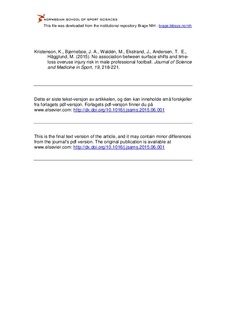| dc.contributor.author | Kristenson, Karolina | |
| dc.contributor.author | Bjørneboe, John Andreas | |
| dc.contributor.author | Waldén, Markus | |
| dc.contributor.author | Andersen, Thor Einar | |
| dc.contributor.author | Hägglund, Martin | |
| dc.contributor.author | Ekstrand, Jan | |
| dc.date.accessioned | 2016-06-29T10:20:24Z | |
| dc.date.available | 2016-06-29T10:20:24Z | |
| dc.date.issued | 2016-03 | |
| dc.identifier.citation | Journal of Science and Medicine in Sport. 2015, 19, 218-221 | nb_NO |
| dc.identifier.uri | http://hdl.handle.net/11250/2394574 | |
| dc.description | Dette er siste tekst-versjon av artikkelen, og den kan inneholde små forskjeller fra forlagets pdf-versjon. Forlagets pdf-versjon finner du på www.elsevier.com: http://dx.doi.org/10.1016/j.jsams.2015.06.001 /
This is the final text version of the article, and it may contain minor differences from the journal's pdf version. The original publication is available at www.elsevier.com: http://dx.doi.org/10.1016/j.jsams.2015.06.001 | nb_NO |
| dc.description.abstract | Objectives:
To investigate frequent surface shifts and match play on an unaccustomed surface as potential risk factors for injury in Scandinavian male professional football.
Design:
Prospective cohort study.
Methods:
Thirty two top-division clubs (16 Swedish, 16 Norwegian) were followed during seasons 2010 and 2011. The influence from (1) number of surface shifts (between artificial turf and grass) during five-match sequences, and (2) match play on an unaccustomed surface (other surface than on the home venue) on subsequent overuse injury risk was evaluated with generalized estimating equations (GEE). GEE results are presented with risk ratios and 95% confidence interval (CI). Injury rate was expressed as time loss injuries/1000 h, and compared between groups with a rate ratio and 95% CI.
Results:
No association was found between the number of surface shifts and subsequent overuse injury risk (risk ratio 1.01, 95% CI 0.91–1.12). Furthermore, no difference was seen in subsequent overuse injury risk after match play on unaccustomed compared with accustomed surface (risk ratio 1.04, 95% CI 0.78–1.38). Grass clubs (grass installed at home venue) had a lower match injury rate when playing away matches on artificial turf compared with away matches on grass (rate ratio 0.66, 95% CI 0.40–0.89).
Conclusions:
This study showed no association between surface shifts or playing matches on an unaccustomed surface and time-loss injury risk in professional football, suggesting that clubs and players can cope with such surface transitions. | nb_NO |
| dc.language.iso | eng | nb_NO |
| dc.publisher | Sports Medicine Australia | nb_NO |
| dc.subject | epidemiology | nb_NO |
| dc.subject | lower extremity | nb_NO |
| dc.subject | soccer | nb_NO |
| dc.subject | surface | nb_NO |
| dc.subject | surveillance | nb_NO |
| dc.title | No association between surface shifts and time-loss overuse injury risk in male professional football | nb_NO |
| dc.type | Journal article | nb_NO |
| dc.type | Peer reviewed | nb_NO |
| dc.subject.nsi | VDP::Social science: 200 | nb_NO |
| dc.subject.nsi | VDP::Social science: 200::Social science in sports: 330 | nb_NO |
| dc.subject.nsi | VDP::Social science: 200::Social science in sports: 330::Other subjects within physical education: 339 | nb_NO |
| dc.source.journal | Journal of Science and Medicine in Sport | nb_NO |
| dc.identifier.doi | 10.1016/j.jsams.2015.06.001 | |
| dc.description.localcode | Seksjon for idrettsmedisinske fag / Department of Sport Medicine | nb_NO |
